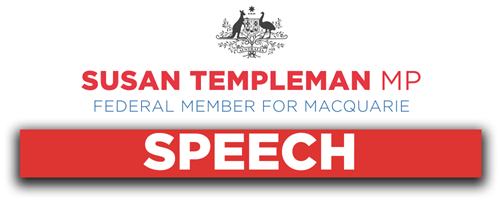
Before we had COVID, we had a problem in child care. Now let's be realistic. The care of children is the responsibility of both parents. But, often, the secondary wage earner is a woman, and the family measures the costs of child care against that second wage. What will it cost to go back to work? What will be lost on child care? How much better off will I be or will we be financially once those childcare fees are paid? Will it be worth the mornings trying to get me and the child out the door—not the good mornings, not the mornings where your child eats their breakfast and happily wears the shorts that are clean and remembers that today is Teddy Bear Day and pops their bear in the bag, but the bad mornings where nothing goes right and, just as you're about to race out the door, a three-year-old mashes a banana into your suit, maybe with a grin, maybe with a tantrum. We've all had those mornings and asked ourselves, 'Is this worth the money?' I'm two decades away from having had those mornings, but women tell me that not much has changed. Kids are still kids, and the system designed by this Prime Minister still incentivises women to work three days a week but no more. They actually lose money for working four or five days a week. Before COVID, childcare costs were rising. The government subsidy system had a 4.6 per cent hike in fees in 2019 when inflation only went up 1.8 per cent. Out-of-pocket costs soared by 7.2 per cent in the year that we have the last data for. This third-term Liberal government has now overseen a 34 per cent increase in fees so that child care costs as much as an extra $3,800 a year.
Another major flaw in the government's approach to child care is that they don't view early education as just that. Play based education is crucial for brain development in the under-fives. Those opposite seem to see it purely as babysitting, but it is so much more than that. Quality early learning is the most effective use of the education dollar. On this side of the House, we see spending on early child learning as an investment, whether that's an investment in the educators who guide the children or investment to fund a child's attendance.
On one of these measures, COVID showed us another way. Families were given free child care. I'll say from the outset that the model used by the Morrison government was far from perfect for the childcare centres in the Blue Mountains and Hawkesbury. The sector wasn't consulted about how to keep the doors open and keep their staff employed. There were what I will kindly call unintended consequences that came from not understanding the sector and not bothering to speak to them before announcing to the world that things would change and, in fact, would change in just a couple of days. As further changes occurred, even those were not communicated directly to the sector, but they had to hear about it via the media. Directors of early learning centres went through hell at that time and, along with their workers, deserve our thanks for demonstrating the role they play as absolutely essential workers.
For many of the families I have spoken to, aside from some guilt in not paying when they felt they still could, the change was a revelation. This was particularly so for women whose work is not necessarily regular, such as casual workers who might get more work some weeks than others, workers who need to be flexible to meet employers' demands and self-employed people whose work goes up and down. For the first time they didn't have to do that calculation in their head about whether it was worth a day's child care, and it was liberating. People were able to say yes to whatever work was available, and often those people were women. But the liberation was short lived.
Knowing that 200,000 women have lost work in this Morrison recession so far, we know how many we need to see back at work, so let's be plain. The question is: how can people go back to all these promised jobs if they can't afford child care or if they lose money for working? Women's economic security is best secured when they can work the days and hours that they want. As well as boosting our kids, investing in early learning boosts workforce participation, and boosting workforce participation increases economic growth. That's why it's such a surprise that not only was there no plan for social housing or aged care in this budget but there was also no plan for child care in this budget. When it's such an important piece in the puzzle, it's unbelievable that, in a trillion dollars, they couldn't find a cent for chil


